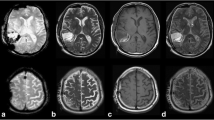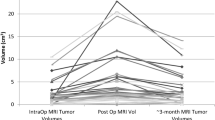Abstract.
Fluid-attenuated inversion-recovery (FLAIR) imaging has shown to be a valuable imaging modality in the assessment of intra-axial brain tumors; however, no data are available about the role of this technique in the clinically important postoperative stage. The purpose of this study was to evaluate the diagnostic potential of FLAIR MR imaging in residual tumor after surgical resection of cerebral gliomas. Fifteen patients with residual cerebral gliomas were examined within the first 18 days after partial surgical resection of cerebral gliomas. The imaging protocol included T1-weighted spin echo, T2- and proton-density-weighted fast spin echo, and FLAIR imaging with identical slice parameters. T1 and FLAIR were repeated after contrast media application. Detection and delineation of residual tumor were the primary parameters of the image analysis. Additionally, the influence of image artifacts on the image interpretation was assessed. On FLAIR images residual signal abnormalities at the border of the resection cavities were observed in all patients, whereas T2- and T1-weighted images present residual abnormalities in 13 of 15 and 10 of 15 patients, respectively. The FLAIR imaging was found to be superior to conventional imaging sequences in the delineation of these changes and comparable to contrast enhanced T1-weighted imaging in the delineation of residual enhancing lesions. Because of protein cell components and blood byproducts within the resection cavity, FLAIR imaging was unable to suppress the cerebrospinal fluid (CSF) in 4 patients. After the decomposition of proteins and blood, CSF could again be completely suppressed and residual or recurrent tumors were clearly identified. Our preliminary study has shown that FLAIR may be a valuable diagnostic modality in the early postoperative MR imaging after resection of cerebral gliomas due to its better delineation of residual pathologic signal at the border of the resection cavity. It should therefore be integrated into the early and/or intraoperative MR imaging protocol.
Similar content being viewed by others
Author information
Authors and Affiliations
Additional information
Electronic Publication
Rights and permissions
About this article
Cite this article
Essig, M., Metzner, R., Bonsanto, M. et al. Postoperative fluid-attenuated inversion recovery MR imaging of cerebral gliomas: initial results. Eur Radiol 11, 2004–2010 (2001). https://doi.org/10.1007/s003300100856
Received:
Revised:
Accepted:
Published:
Issue Date:
DOI: https://doi.org/10.1007/s003300100856




